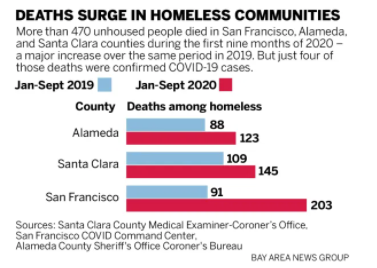PUBLISHED: November 1, 2020 at 6:00 a.m. | UPDATED: November 2, 2020 at 8:47 a.m.
The coronavirus pandemic seems largely to have spared the Bay Area’s homeless communities — few members have succumbed to the virus, and pandemic programs moved thousands of people into hotels and trailers.
Despite those efforts, the number of homeless people dying is skyrocketing.
Deaths in Alameda County’s unhoused communities increased 40% during the first nine months of 2020, compared to the same period last year. In Santa Clara County, deaths climbed 33%. They rose a staggering 123% in San Francisco.
Contra Costa County reported the lowest increase — 30% — but cautioned the Coroner’s Division may not accurately capture the housing status of all decedents. And while San Mateo reported just 20 deaths between January and September, that’s 54% higher than last year.

Those spikes were not directly caused by the virus: Just four of the 560 deaths reported in five-county Bay Area were confirmed COVID-19 cases. Instead, experts say, homeless populations are getting older and sicker, drug use is soaring, and the pandemic has made it more difficult for unhoused people to access healthcare and other services. And, there are more people on the streets to begin with.
For the outreach workers who get to know these people, and struggle to find them housing and help, each death is devastating. But it’s also a reminder of what is at stake when local officials write policies to address homelessness.
“Every year we lose people that we have cared for. That we have served,” said Andrea Urton, CEO of HomeFirst, which holds an annual memorial for unhoused people who die in Santa Clara County. “And we want to make sure the people in power, the people responsible for approving the housing, the people responsible for making sure services are engaged in the community — we want them not to forget out unhoused neighbors. We want them to remember if they don’t do something, someone is going to die and it will be on their hands.”
Each death provides a snapshot into the dangers of life on the streets. People died of drug overdoses and chronic alcoholism. They died in fires or drowned while intoxicated. They were hit by cars and trains, died by hanging or gunshot wounds, and succumbed to hypothermia. Some were malnourished. Men and women in their 70s died of heart disease, and babies not yet born died with methamphetamine in their systems.
“Homelessness is really devastating to health,” said Dr. Margot Kushel, a UCSF professor of medicine at Zuckerberg San Francisco General Hospital and director of the UCSF Center for Vulnerable Populations. “And it’s devastating to mental health.”
As the homelessness crisis has grown in the Bay Area, the number of people dying without a home also has increased steadily. But now, in some places, it’s happening more quickly. For example, in San Francisco, deaths increased by less than 10% between 2017 and 2018, and 2018 and 2019. This year, they’re up 123%.
The last state-wide count of homeless residents was in 2019, and the next won’t happen until January, so it’s impossible to tell how much of this year’s surge in deaths can be explained by a spike in the overall unhoused population.
In San Francisco, this year’s big increase in deaths likely is due to drug overdoses, according to Dr. Barry Zevin, medical director of street medicine and shelter health for the Department of Public Health.
Zevin’s office has not yet finalized cause of death information for the cases, but addiction and overdoses — with fentanyl at the forefront — have become a plague on San Francisco’s streets.
“It’s an out of control, massive drug crisis,” said 50-year-old Thomas Wolf, a drug policy reform advocate who faced addiction and homelessness himself in San Francisco before entering rehab in 2018.
And it’s not just San Francisco. In Alameda County, drugs or alcohol caused or contributed to more than a third of deaths in the first nine months of this year — compared to less than a quarter in 2017.
“Pretty much everywhere, in all the encampments, we see drug use,” said Alameda County Sheriff’s Office spokesman Sgt. Ray Kelly. “Fentanyl has been probably one of the worst drugs that has come into our society. It really is, it’s just as bad as the pandemic. It’s killing people at alarming rates.”
And coronavirus is making it worse, Kushel said. Typically, health professionals advise drug users to use with someone else, in case of an overdose. But with congregating discouraged during the pandemic, more people are getting high alone.
The pandemic also has impacted the region’s many elderly homeless residents who suffer from chronic health issues such as heart failure and diabetes, Kushel said.
As COVID-19 disrupted normal health services, most doctors began conducting preventative care appointments virtually instead of in-person — making it hard for unhoused people without access to a computer, phone or internet to receive care. That interruption is especially devastating for homeless communities, where about half of people are over 50, and people’s bodies generally break down at the same rate as someone 20 years older, Kushel said.
That helps explain why deaths spiked this year despite a massive push by state and local authorities to move unhoused people into hotels and other temporary housing, in an effort to protect them from COVID-19. Many of the people in the program already were chronically ill, and for some — like 65-year-old Terry Hammer — a bed indoors wasn’t enough. Four months after moving into a Milpitas hotel, Hammer, who had struggled with alcoholism for years, died of sudden cardiac arrest in August.
Though they couldn’t save everyone, Kushel still thinks those efforts made a significant impact.
“No matter how bad it is,” she said, “it would have been much worse had we not done all these things.”
